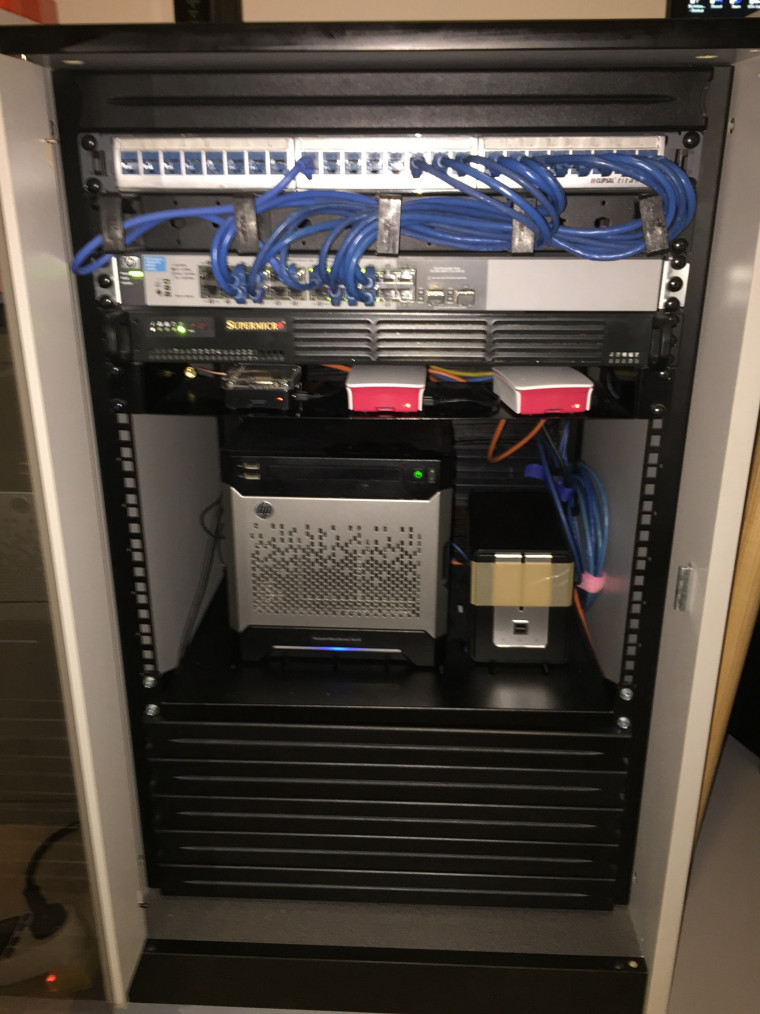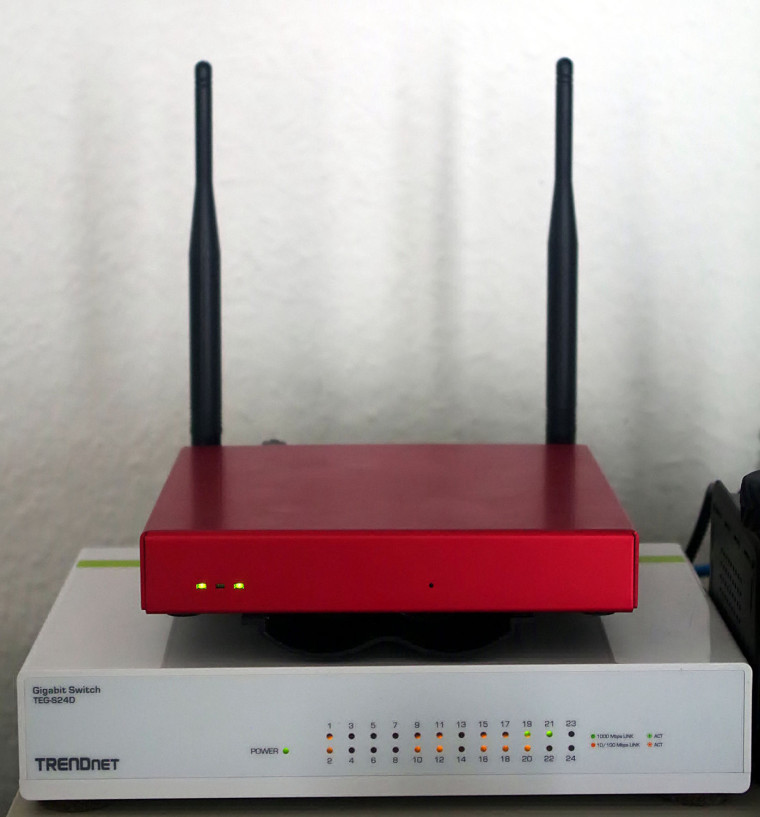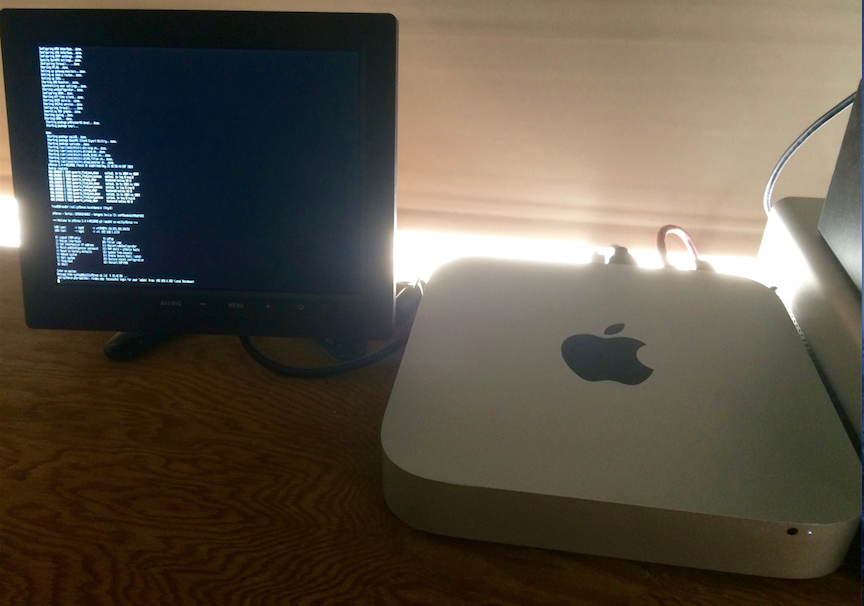[ Show your pfSenses! ] - Thread - (bandwidth warning!)
-
Fractal Design Node 202
Intel Core i5 7600K
ASRock Z270M-ITX/ac
16GB DDR4
Intel Optane Memory 16GB M.2 (There's a 250G Samsung 960 Evo in the photo, it was way too big, so I reclaimed it)
Intel X550-T2
Running 2.4.0 beta
 -
Running an ugly little AMD AM1 vmware box, 16G RAM at my home.
Windows 10, Vmware Workstation It has just enough juice to run PFSENSE 2.3,Domain Controller, fileserver, and my plex server.
Most of the build was from spare parts, the RAID card was the most expensive item.
I recently was running 70+Meg internet on a usb NIC, but upgraded to a cheap Intel pcie. I'm mentioning it because some people had questions about running pfsense on a usb nic, I had no notable problems other than the clunky vmware network configuration. Note I used workstation and not ESXi.
-
Pfsense can use intel optane?
-
My hardware setup. Software setup is pending ;)



-
hello, my setup.
PFSNSE version:2.3.4-RELEASE-p1
SYSTEM:
HP DC5700 small form factor
CPU:
Intel(R) Core(TM)2 CPU 6300 @ 1.86GHz
RAM
4GB of DDR2800
HDD:
Seagate 120GB SATA
NIC:
X3 GB realtek Nics.Packages:
Snort
Squid
squidguard
Lightsquid
Status_Traffic_Totals
pfblockerngsystem has been running with no issues and doesn't take up to much ram, i used to us Smoothwall and it doesn't compare to PFSENSE
-
Not Done, but getting there.
Full disclosure this is my first 1u build, is a challenge with cables. I am going to be redoing the cabling later, and also changing the CPU out and changing the ram to 2 sticks.
For now here she is :).
Istarusa case, 1U. Faceplate painted red.
Asus P106i motherboard
Skylake G440 (soon to be replaced with a E3 1240 V6)
8gb DDR4 ECC (Soon to be 16gb and hestsinked)
2 STEC Mach 16 50gb SLC ssds in Z Mirror.
Intel I350 T4 Nic (plus 2 onboard i210 ports)
Seasonic 300w modular Flex ATX power supply (way more wattage then needed, but fan never turns on :p, plus it's a great PSU.)
3x Noctua A4x20 (had to custom drill 3d slot) and 2x Noctua A4X10, made the SSD cooling fan bracket, and there is another fan hot glued to the i350s hestsink.
Zalman 3p52x CPU Cooler. All fans and CPU cooler are set to max, still much quieter than my Cisco 2960s.I think that's about it :). Oh and running 2.4 RC for the ZFS mirror.

-
My rig

-
My rig
looks amazing, it´s deserve a new photo in high definition for us ::)
do you have any worklog or any step by step about how you made it or what you have inside? :) -
Work in Progress - Probobly one of the weirder setups.
We do event work and next year we take over a large event due to issues with the previous supplier. This is one of two PF powered racks we will use to cover the 100 Acre site.
200Meg LL arrives in the switch at the top via 1KM of Fibre from the 'office'. This loops into the switch at the top and out again via fibre to the next rack (not built)
48port managed Gigabit switch doing all manner of VLAN silliness at the top.
24 port FXS under that. Generates the coltaged for the DSLAM and provides POTs lines to the site locations, lot more resilient than VOIP in this case as the event suffers frequent power issues due to generators.
Next up, 24 port VDSL2 DSLAM. This means we dont have the issues with Wifi the previous guys did but dont have the limitation on ethernet cables and expense of fibre. Yes thats a stack of Openreach modems on the right!
Under that, 24 POTS/VDSL ports
Under that a repurposed and upgraded Smoothwall UTM running ESXI 6
Memory bumped to 8Gb, boot SSD, SSD for Cache and a 1TB Drive for VMs.
Three vms, one running Asterisk/freepbx as a local PBX slaved to the office system.
One, minimal running Win7 for management, monitoring and looking after the LCD (not installed)
And most of it allocated to PF which provides PPPOE/DHCP services to the DSLAM via a LAGG. DHCP is locked down and used for kit that runs the modems as a plain bridge, CCTV etc. PPPOE runs those in router mode for site offices, wifi access points etc. Squid is used to do some load alleviation and hold a local cache, this has raw access to the cache drive (only has to survive a week). One network allows direct access to our Sat link for use ONLY with NHS IT for the Medical team, their traffic is kept clear of everything else and encrypted all the way through from the router in the hospital all the way oput to the NHS systems. This traffic only goes onto the Fibre as a VLAN and then picked back out further up at the switch with our Sat gear. To get at this traffic one would need to compromise the PF box, or switch, or the fibre and the VPN. Regardless unless the VPN is compromised there's no point anyway.At the bottom a large ups supplied by two external 12V AGMs
It also looks after the modified UPS at the bottom of the rack, provides captive portal for WiFi acees and one port is direct access to the Windows machine for testing modems etc without the hassle of having a laptop sat there too.
Oh and the cool thing, this whole rack has cost under £300 to build! That includes the huge pile of 24 VDSL modems.
.jpg)
.jpg_thumb) -
Yes thats a stack of Openreach modems on the right!
Ha! :D
I'd watch the cooling on those modems especially if they are the earlier Huawei model. I've had a number of those that would only work reliably if mounted vertically to allow air flow through the case.
Steve
-
of the 10 we have thus far purchased I've had to re-cap 8 of them. Makes a difference. They sync up at 35/50down and 10 up with the bad caps, after changing them I get 100/50. Def worth a look if you get sudden speed drops. Very rare the whole pile is on. Struggling with SNMP silliness at the moment.
-
Hmm, I've not seen that symptom myself, I'll be checking for it now though. :)
Steve
-
There is one on the front right of the board (EC16) that has failed on a couple too.

-
Ouch, can't argue with that.
Steve
-
PFSNSE version:2.3.4-RELEASE-p1
SYSTEM:
SuperMicro SuperServer 5017A-EFMotherboard:
X9SBAA-FCPU:
Intel Atom
Atom Processor S1260;
Processor S1260;
2.0GHz 8.5W, VT-x, 64-bit, Dual-Core, Hyper-ThreadingRAM:
DDR3-1333 ECC 8GBHD:
2x 2.5inch Western Digital 320GB ( ZFS )NIC:
2x Onboard Intel NicsPower Supply:
200WPackages:
Snort
FreeRADIUS 3
OpenVPN Client Export
There is 3x Raspberry Pi 3 Model B+.
One is running Unifi Controller for the AP's in the House ( right red case )
One is running Nagios ( middle red case)
One is a NTP Server with the Adafruit GPS Hat (left black case )The HP MicroServer G8 is running FreeNAS.
The Dlink NAS 323 is purely a torrent box. -
pfSense version:2.4.3-RELEASE-p1
Motherboard - Asus H110M-K
CPU - Intel Celeron G3930
Ram - 8GB HyperX Fury DDR4-2133
HD - Hitachi 5K500 250GB (from a laptop I had to turf)
Power - EVGA 500B (500w)
NIC - 2 x Intel Gigabit CT
all inside a Cooler Master N200 case -
This post is deleted! -

pfSense C2758 1U firewall appliance, circa July 2014. Still working great! Not hooked up in this photo. But I love it.
-

Pfsense 2.4.4 on a APU2C0 Board with Compex WLE200NX WiFi Card.!

Display is attached via USB. -
My pfSense set up, a 2011 Mac Mini server with 8inch 1080p monitor just to share!

The setup as it is now with the Akitio thunderbolt 2 PCIe enclosure with Intel i350-T2.
